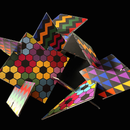Introduction: 3D Tic-Tac-Toe Remixed
This project is a game and a sculpture, which refers to a two- or three-dimensional artwork. In a typical tic-tac-toe game the player who succeeds has to place three of their marks in a horizontal, vertical, or diagonal row. However, for this game, the first player to achieve three of their own blocks in a row wins. The winning row can be horizontal, vertical, or diagonal on a single board as in regular tic-tac-toe, or vertically in a column, or a diagonal line across the game board.
The goal is not just to make a game but to be as creative as possible when making the game and linking it to STEM concepts where possible. As an introduction explore these examples:
Artists Who Make Games/Games as Art:
- Gabriel Orozco, Artist
- Mary Flanagan, Game Designer
- Olalekan Jeyifous, Architect
- Matthew Ritchie, Artist
Ultimate Tic-Tac-Toe: https://www.youtube.com/watch?v=Q78w9f28S3Q
Attachments
Supplies
Tinkercad (for 3D modeling)
cardboard box for the base (ex. shoe box)
sticks (ex. wooden dowels or BBQ skewers, chopsticks)
scrap cardboard to make game pieces or blocks
holes hole punch tool (ex. screwdriver, awl or sharp scissors)
tape or glue
pencil or pen
ruler
optional: paint, markers
Step 1: Create a 3D Model
Although not always necessary, you can create a "quick" 3D model of your project to figure out if the elements will work together. This early model is called a prototype and designers make them to try out their ideas before using real materials that can cost money and time.
For this step, you can use Tinkercad, a free online 3D modeling program that runs in a web browser.
Tinkercad Tutorials:
https://www.instructables.com/id/Tinkercad-Tutorial
https://www.tinkercad.com/learn/designs
A sample .STL file is included with this lesson but you can only open/view it using software that reads this file format (ex. Tinkercad). You can modify the file in whatever way that works for your project..
Step 2: Make Your Base
Use a discarded or old box (i.e., a shoe box) and draw a grid on the box with each square measuring at least two inches in width and height. You should have 9 squares (3 rows, 3 columns). If you have a bigger base you can make your squares (and game pieces) bigger.
To find the center of the square use a pencil to draw diagonal lines from the top left corner to the bottom right corner; then the top right corner to the bottom left corner. Where the lines cross is the center. Do this for each square in the grid.
Punch small holes in the centers of the squares where the diagonal lines meet.
Step 3: Insert Sticks Into the Base
Insert sticks into the holes. In the photo above a wooden BBQ skewer was used to punch the holes in the box grid.
Insert the rest of the sticks and secure the sticks on the bottom to keep them standing straight.
Wait until after you make the game pieces to make adjustments to the sticks.
Step 4: Make the Game Pieces
Make the pieces for your 3D tic-tac-toe game. The pieces can be made of cardboard. For example, you can draw grid with 1" x 1" squares on scrap cardboard, then make different objects such as cubes, X's and O's. Be creative with what you come up with for the design of the game pieces.
There should be two sets of game pieces; each set should look different from the other (ex. X's and O's). Make no more than 20 pieces (5-10 for one set and 5-10 for the second set).
You can also use two colors, one color for each set.
Note: The cardboard game pieces (see above) were modeled from the Tinkercad 3D model.
Step 5: Finish Making the Game
Punch holes in the game pieces, stack three of them on one stick/column and, if necessary, cut off excess material from each stick.
Re-insert each stick in the holes.
Apply glue the base of each stick and let them fully dry. You can use hot glue if you have it.
Step 6: Play the Game
To play the game, each player picks a set of game pieces and places their first piece on a stick/column.
Then, players will repeat this step on a new stick/column or block the other player by stacking a piece on top of theirs.
The winning player has to stack 3 game pieces in a row on one column/stick; moving across one row or diagonally on different levels.
Note: In the image above the X's won.
This project was made possible by the Lesley STEAM Learning Lab, a center designed to research new opportunities for learning through engagement and inquiry-based exploration. Embracing the “maker” way of knowing, this is a place for our students and community partners to play, tinker, design, and create.












